TomKin Forge Backsword E.B. Erickson Basket Hilt
Feb 19, 2018 2:11:42 GMT
Post by Razor on Feb 19, 2018 2:11:42 GMT
TomKin Forge Backsword
E.B. Erickson Basket Hilt
Review By Ray Harrington
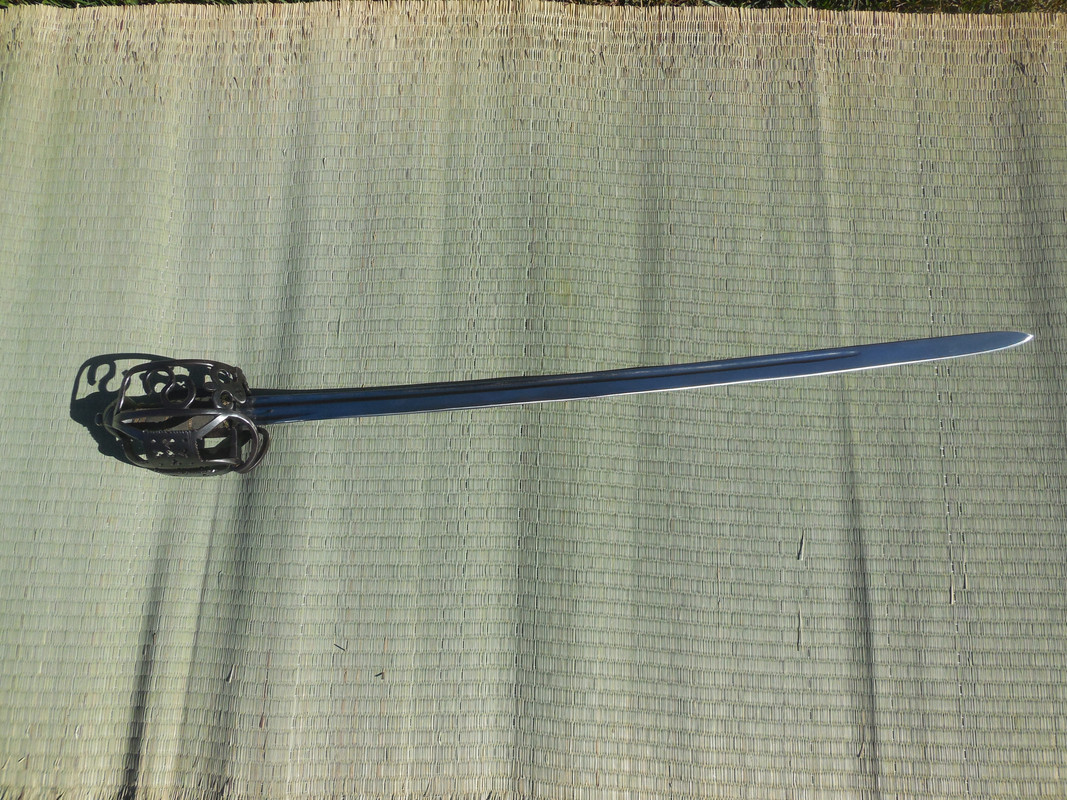
Introduction
When I bought the basket from Tom Kinder of TomKin Forge, I asked him if he could make the blade for it. Tom was up to it, and told me to send some pictures of blades for a reference. Around that time, I was able to handle seven antique basket hilt swords. I took pictures of all seven and obtained mesurements for six of them at Davenriche European Martial Art School. The blade that I liked was from one of the antiques, and sent the measuremnets and pictures of it to Tom. Unfortunately, Erickson's basket was heavier then the antique one. Tom had to really do some engineering on the blade in order for the sword to obtain the same blance and handling characteristics as the antiques. He also had to have the base of the blade thicker so it could fit into the basket.
The antique backsword that was used for reference.
Full Disclosure
I'm friends with Tom, and I've known him since the early days of SBG Forum. I paid full price for the sword.
Initial Impressions
As you can see in the pitures, the sword was securely packaged in the box with foam. It was packaged tightly for optimum delivery of the sword. I had to put in a lot of force to pull the sword out. It was almost like Arthur pulling Excalibur out of the stone, lol.
After I pulled the sword out of the box, I could instantly feet how hilt heavy this sword is. This sword is sharp, as well as being the sharpest sword out of the box that I have ever experienced. The edge easily saved hair off of my arm. When going through guards while executing some dry cuts, I found the sword to be quite nimble. I can't wait to cut with it and see what it can do.


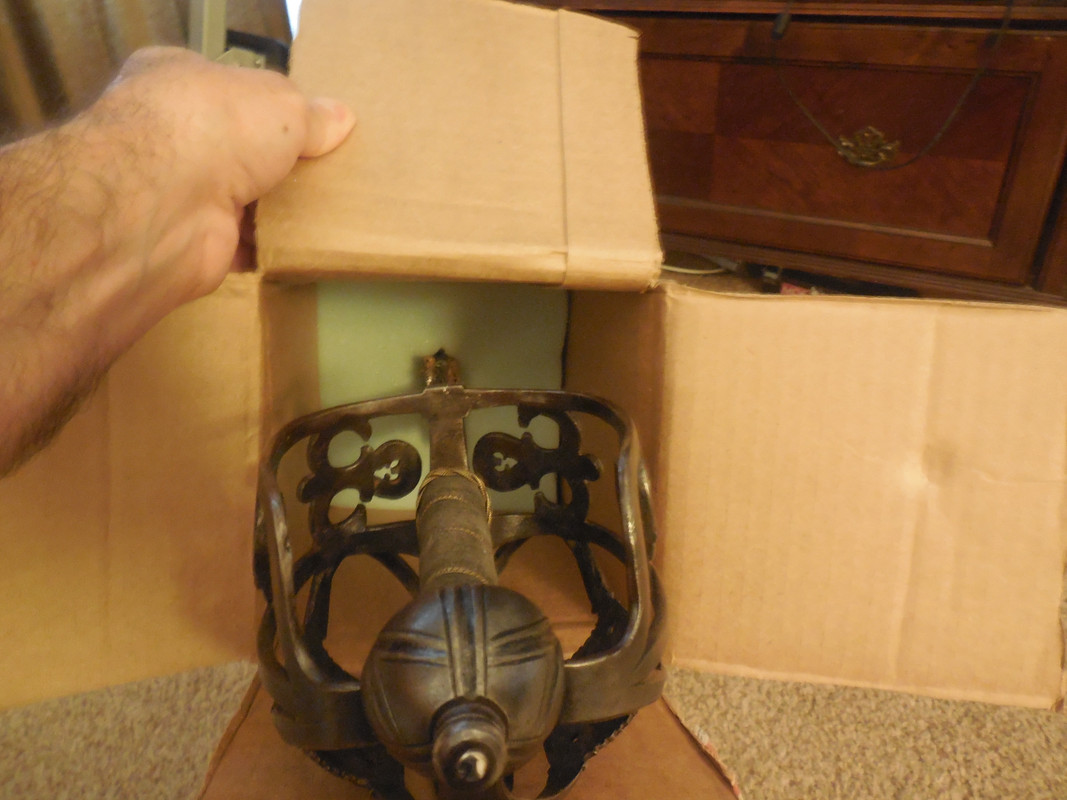
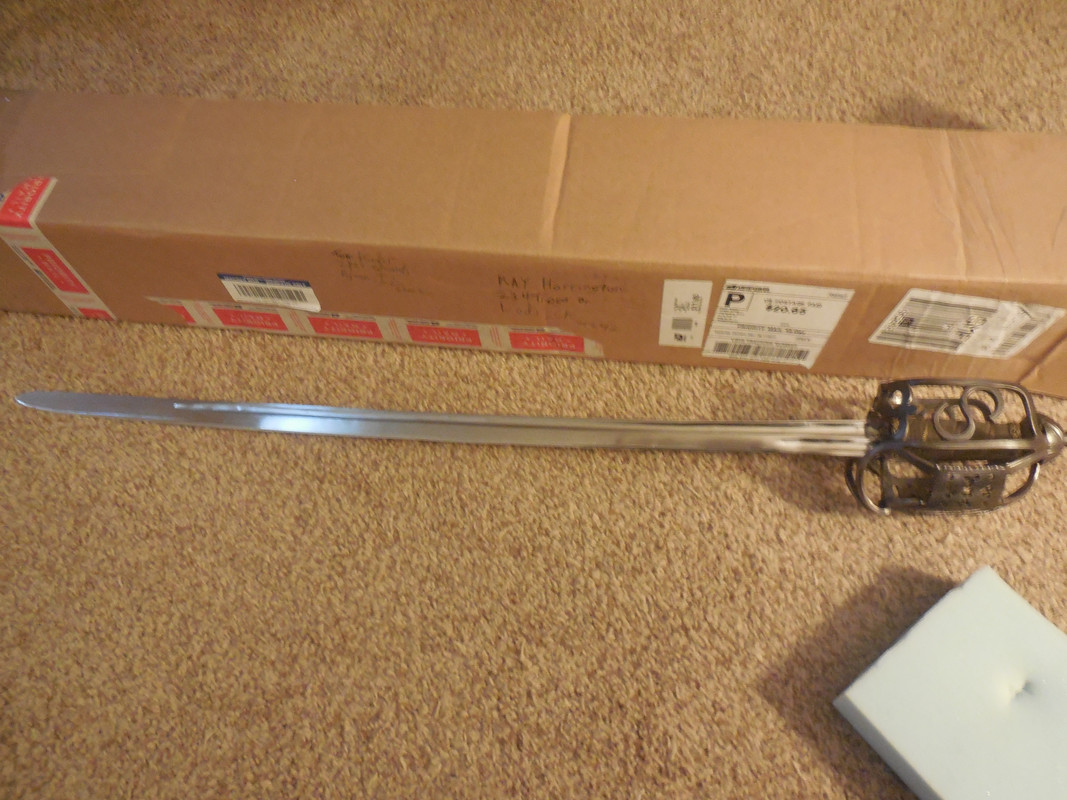
Statistics
Over All Length: 38 5/8"
Blade Length: 33"
Handle Length: 4"
Weight: 2lbs 14oz
POB: 2"
COP: 22 1/4"
Distal Taper: basket .220"(5.58mm), POB .197"(5mm), COP .094"(2.38mm), three inches fron tip .084"(2.13mm), one inch from the tip .083"(2.10mm)
Blade width: basket 1 1/4", POB 1 3/16", COP 1 3/64", three inches from tip 1", one inch from the tip 23/32"

Basket
The basket is a Manzansky Type E3 rear S shape filler with flattened rectangular bars. It has a knuckle plate and two shield plates. The shield piercings design are in the Heart Family A Type iv. The hilt and handle is made by E.B Erickson and it weighs 1lbs 14oz and it is almost an exact copy of a 1650 basket hilt in the "British Basket-Hilted Swords" book.
The outside measurements: From the top of the rear quillon to the bottom of the bars the basket is 4 3/4" tall. The width is 4 9/16". The length from the knuckle plate to rear guard is 4 1/4"
The inside of the basket: 4' tall. length from the inside of knuckle guard and rear guard 4 1/8". The space between the knuckle guard and the front of the handle 1 13/16". The width od the opening/mouth of the basket 3 7/8". The widest part of inside the basket 4 7/16"
The measurements of the basket are very close to the antique baskets that I had previously handled and measured. The bars on this one looks to be too thick and adds unwanted weight to the basket.
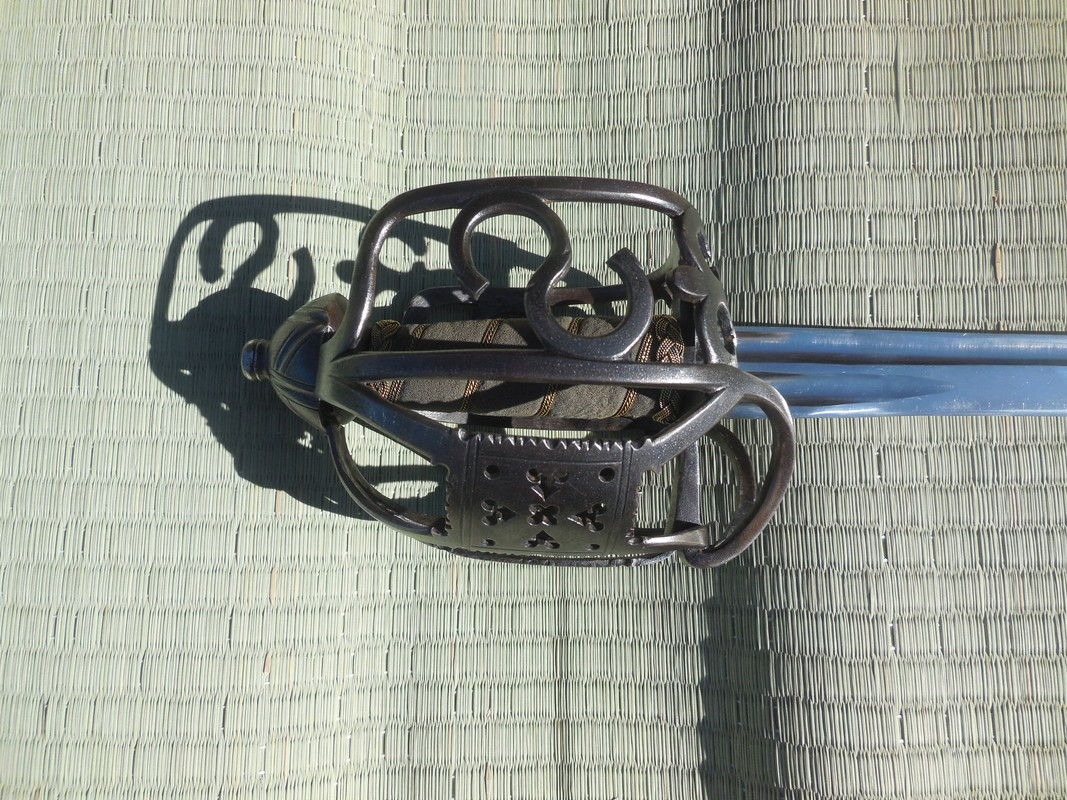
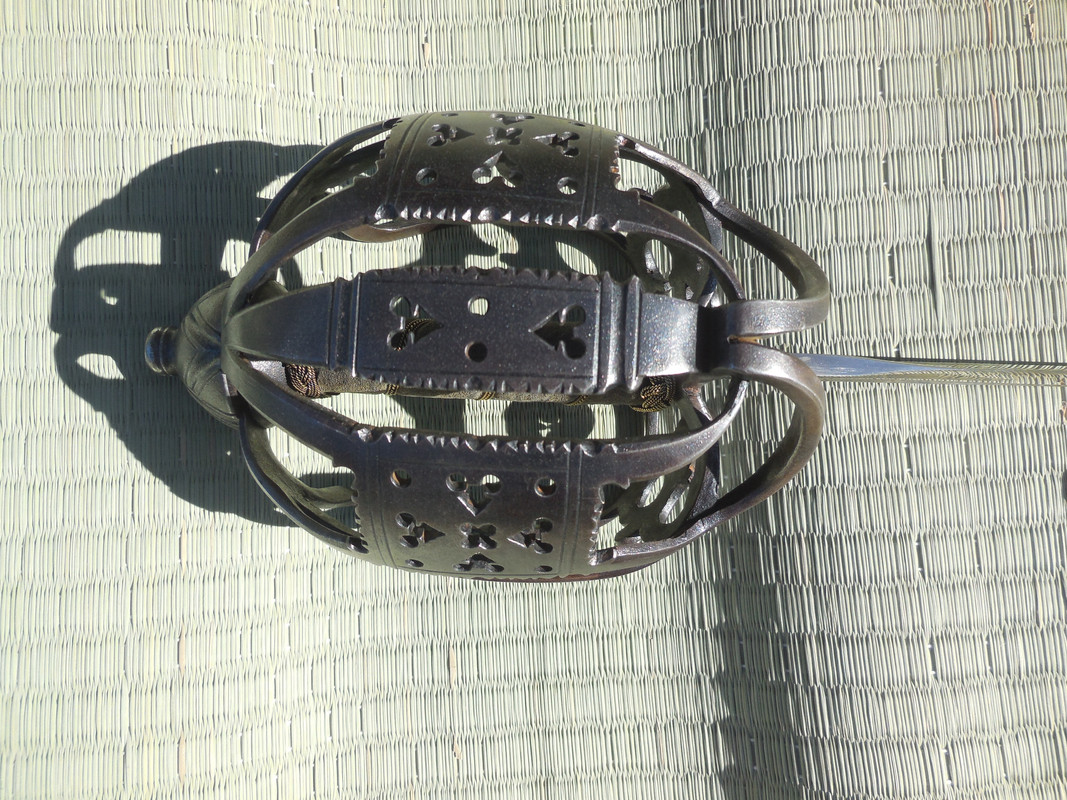

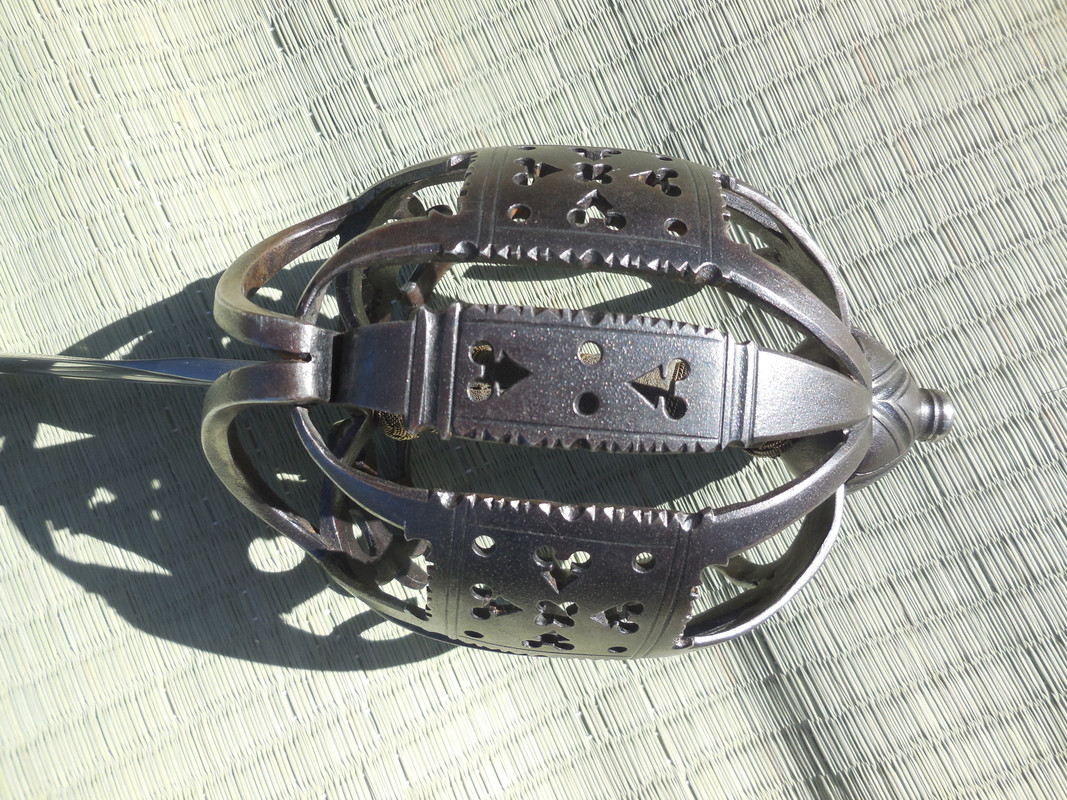

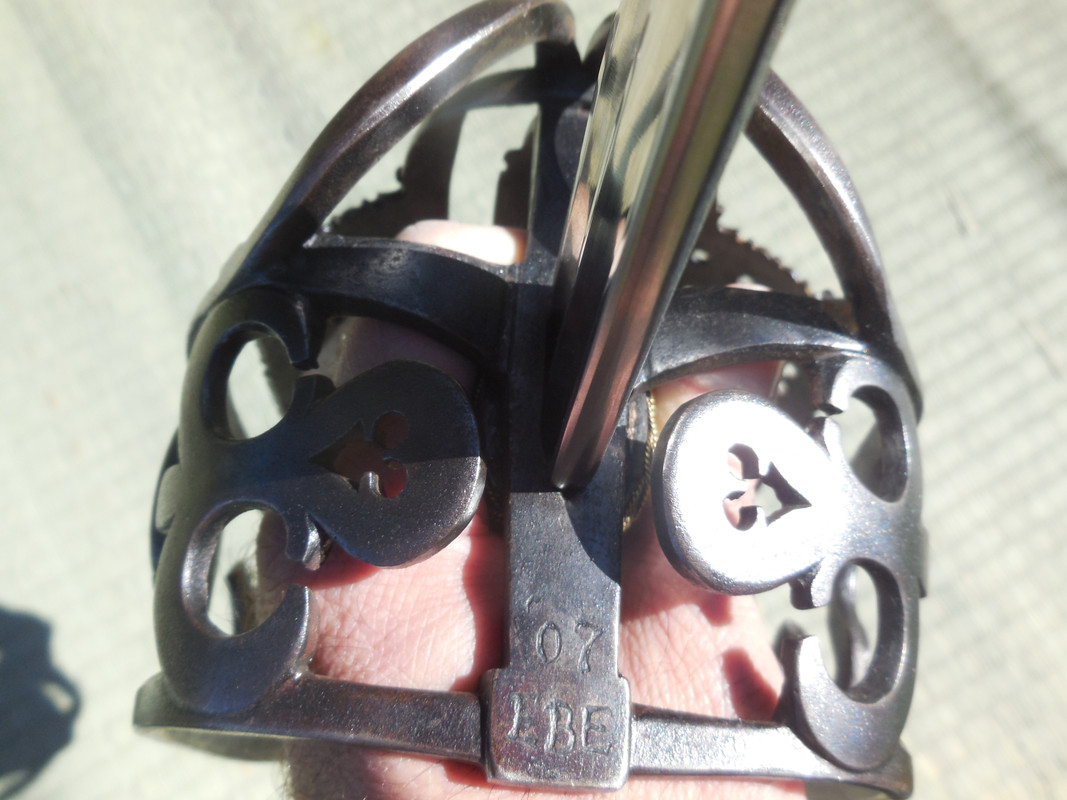
Erickson did a fantastic job on this basket and you can see how close it to this 1650 basket hilt.
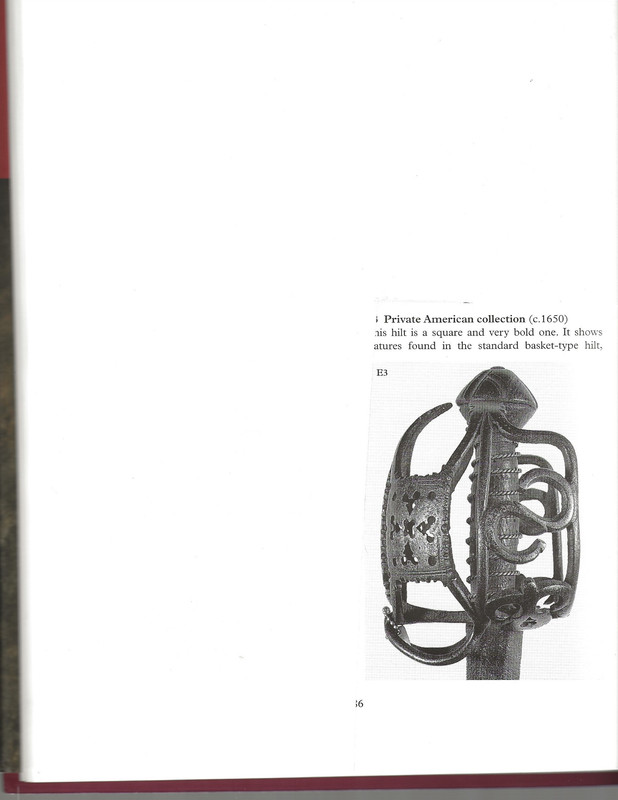

Blade
Making a blade for a 1lbs 14oz bakset and still have the weight, balance, and handling characteristics of the antiques isn't a small feat. This is were Tom does his magic.
The blade is a backsword with two fullers and weighs 1lbs and was forged from 3/4" round bar of L6 steel. The longest fuller on the back side of the blade 25 5/8". Th smaller fuller is 3 1/8"
There is some waviness in the fullers, and they are rough and not polished as to Tom's standards. He had to go deep with them to take weight off to get the sword to balance right, and was worried that he would go through the blade.
The thickness of the blade at the base was determined by the basket. He had to start at .220" so it would mate properly with the basket which was .024" thicker that the antique we used for the guideline. He left 10-20 thousandths thicker in the foible than the antique blade for two reasons: I wanted it a little stiffer for thrusting and Tom, needed it thicker to move the weight forward. Tom, didn't add a back edge so it would help with keeping the weight forward. He also had to change the fullers as opposed to the one that was being used as a guideline, in order to get this sword to handle and balance correctly. Tom also had to make them thicker and wider in order to take some weight of the blade and also distribute more of the weight forward.
The blade has a razor sharp convex edge with a HRC of 61 and the spine was seletctively drawn back to 51 HRC. During the process of drawning back the spine of the blade to HRC51, the blade curved 1/8" deep. Tom, contacted me explained what happened and sent pictures of the blade. Tom gave me a choice. He could either scrap it and start over, or if I was ok with it, he would continue using the blade. I didn't mind the cure and I like the way it looked on the hilt.
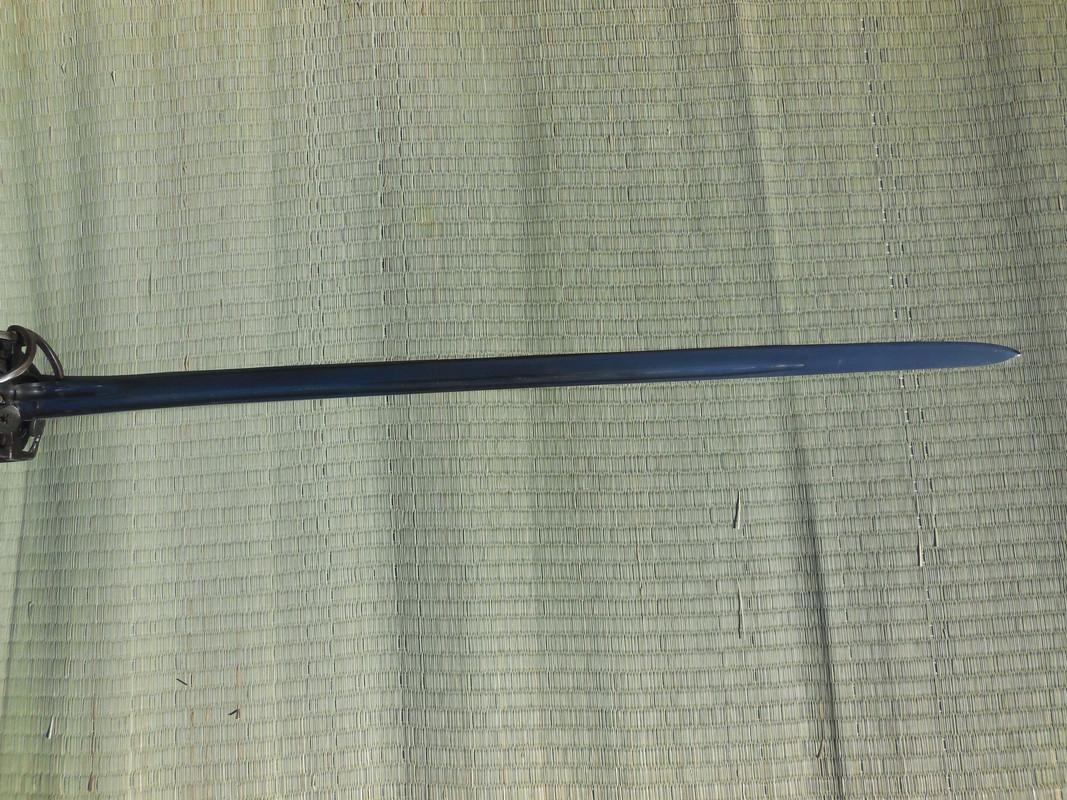


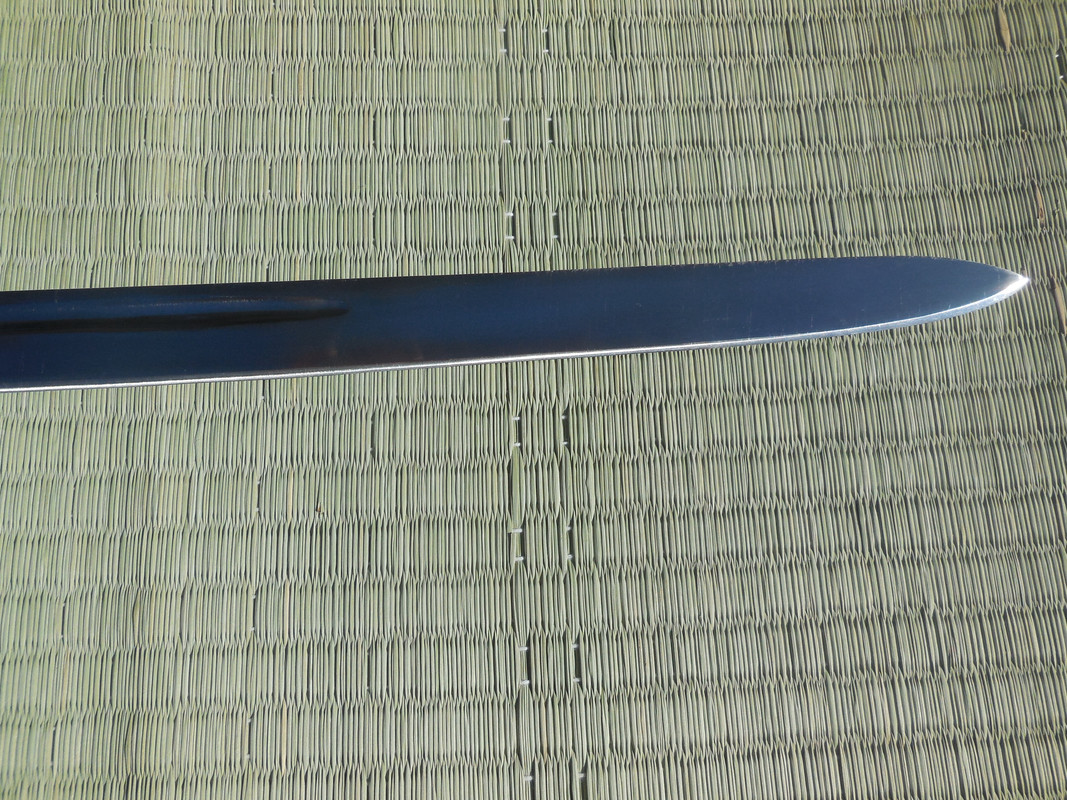
Handle
The handle has a wooden core with shagreen (shark skin) wrapped around it, with triple cooper wire ropes spiraling down the handle and 5/16" turks head ferrules at each ends.

Pommel
The pommel is a type V with a fluted surfaces and a tang button that is actually a threaded nut. The knuckle guard and side guards fit into the pommel's groove. The difference between this pommel and the 1650 one, is that this pommel's knuckle guard fits into it's groove and the tang button.
Tom epoxied the threaded tang button to the tang and ginded the remaining tang down to look like it was peened.
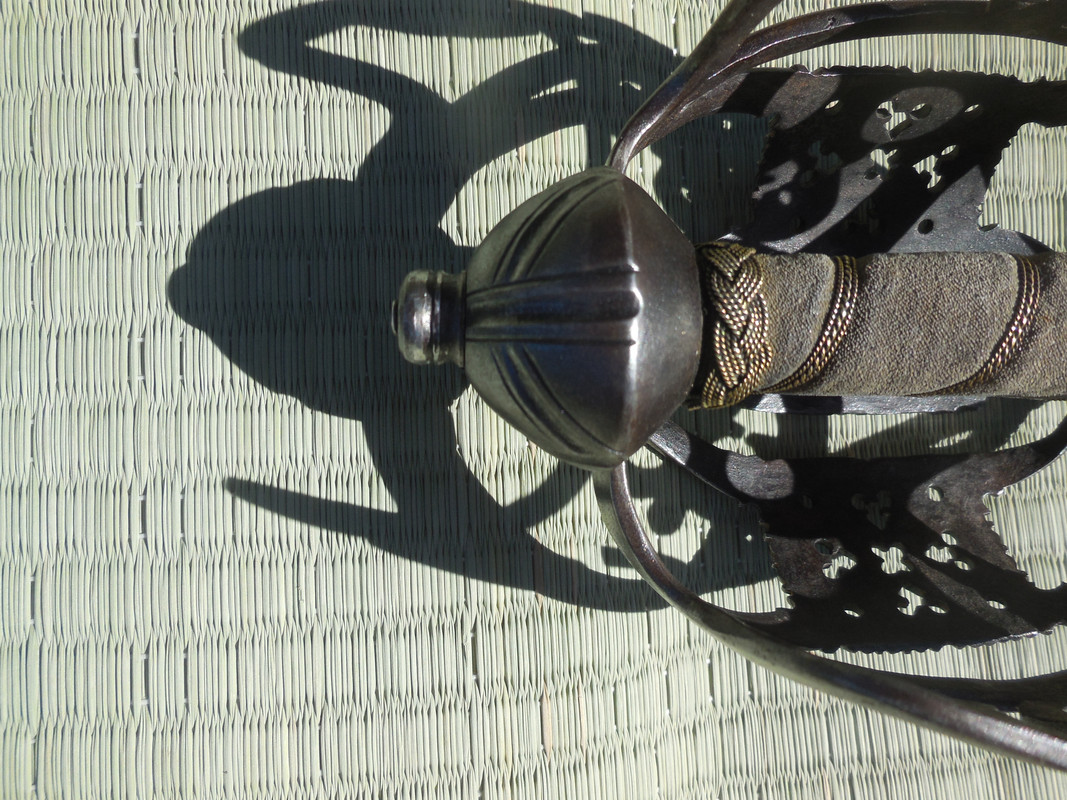
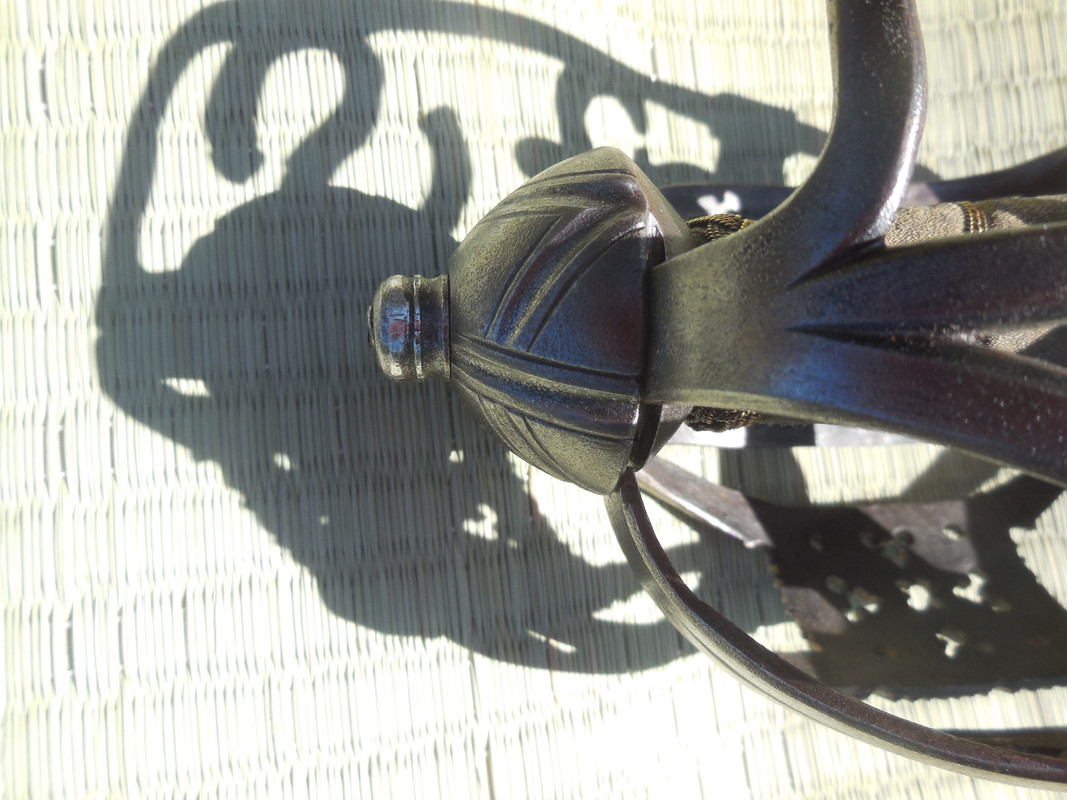
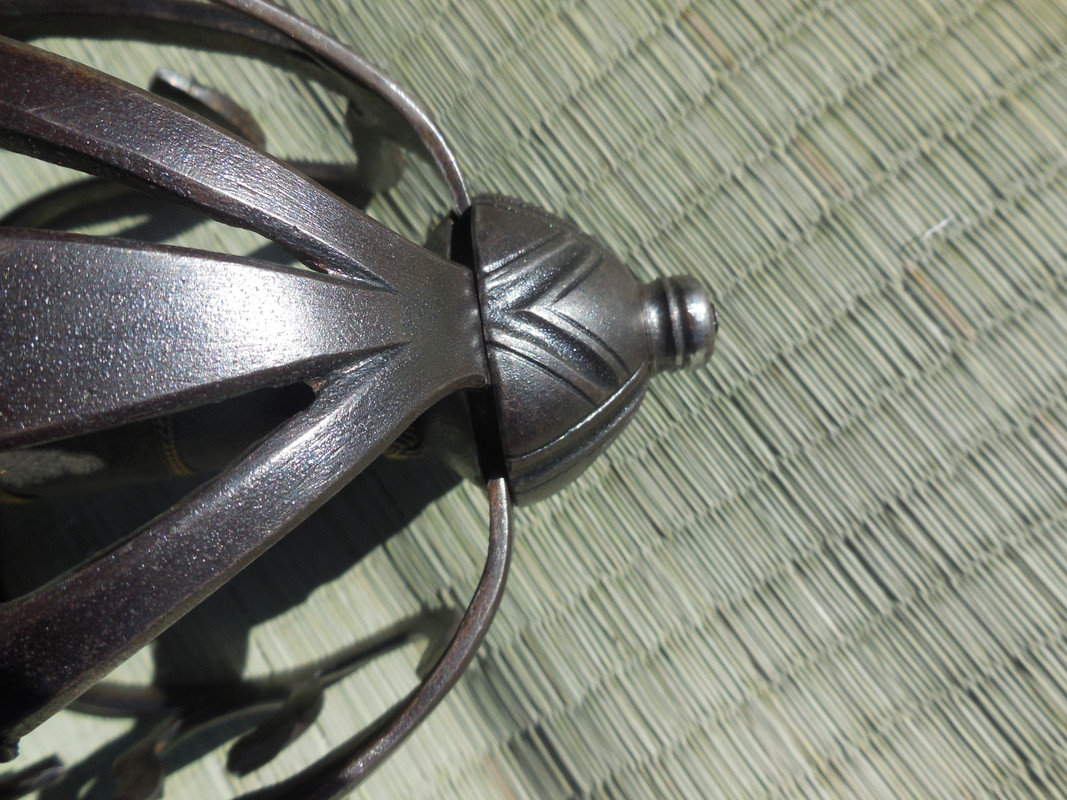
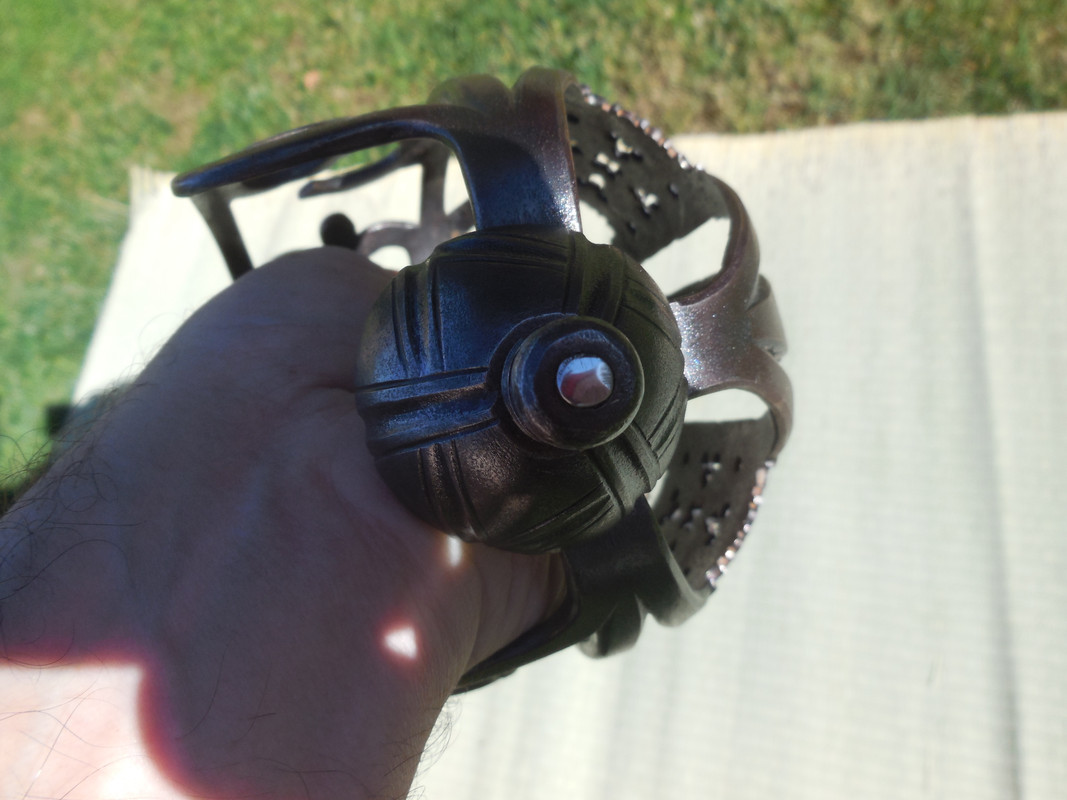
Cutting
I used Mugen Dachi tatami mats, 1" manlia rope, a gambeson made by Lord Of Battles over pork ribs, a pumpkin, and 2 liter soda bottles. Before Tom sent the sword off, he mentioned that the sword had a 2" POB and that he thinks it should cut single mats fine, but didn't think it would be able to cut double mats. All that made me want to do was to try to cut a double mat with the sword for the test video.
This was the first time cutting with the sword, and since it has a 2" POB, I put a little bit to much force than I needed when cutting the first single mats. The sword did well thrusting into the gambeson and ribs. The blade was slipping between the rib bones nicely in hand positions 2 and 4. One of the trust in hand position 3(5:31) the point did not slip between the ribs and hit the bone. The blade flexed like it is supposed to do; springing back without taking a set and the tip wasn't damaged. The sword did very well cutting through the gambeson, pork ribs, and bag. I should of been more to the right on the first cut so that it would have been in a better position to cut deeper in to the ribs.
Cutting with this sword is a lot of fun. For three months straight I have been cutting warter bottles, 2 liters, milk jugs, and tatami mats once to three times a week. In that time all I've done was strop the edge with a leather belt to keep it's sharpness.
Conclusion
The sword is great and I'm very happy with it. Tom was great to work with, and kept me updated on his progress with pictures and messaging me on FaceBook Messenger.
The blade wasn't supposed to be curved, but Tom gave me the option to stay with this blade or start over on a new one. I didn't mind it and thought it looked good. It didn't take away from the preformance of the sword, as seen in the video. The fuller are a little rough on the inside and not as good as Tom would have liked. There were a couple of spots in the fullers that were getting too thin, and he didn't want to push it. The only real thing I could complain about, are the belt scratches from sharpening not polished out.
I will defintitely be doing more business with Tom, and will have no problem recommending Tom to anyone wanting a sword.
I will leave some of the pictures that Tom sent me on the prgress of the blade below.
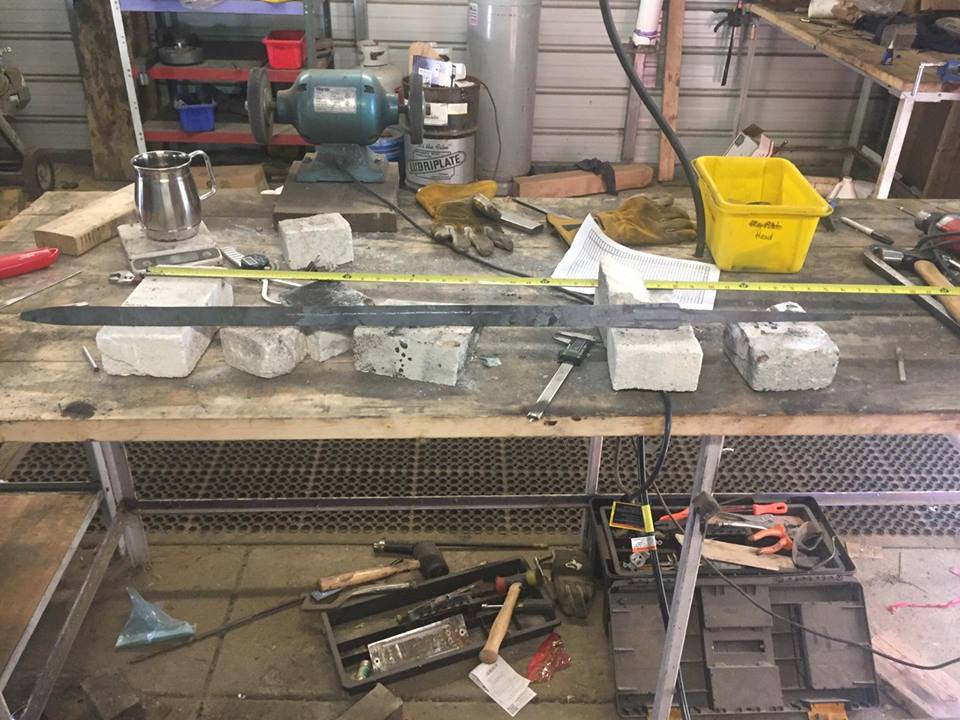
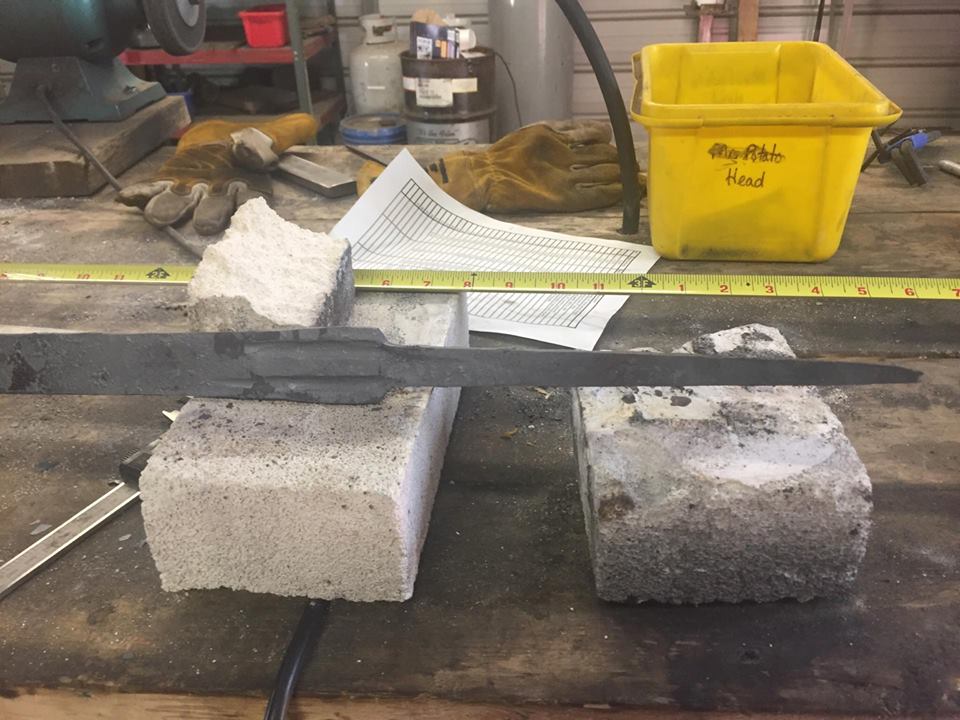


Thank you for reading my review
Ray Harrington
E.B. Erickson Basket Hilt
Review By Ray Harrington

Introduction
When I bought the basket from Tom Kinder of TomKin Forge, I asked him if he could make the blade for it. Tom was up to it, and told me to send some pictures of blades for a reference. Around that time, I was able to handle seven antique basket hilt swords. I took pictures of all seven and obtained mesurements for six of them at Davenriche European Martial Art School. The blade that I liked was from one of the antiques, and sent the measuremnets and pictures of it to Tom. Unfortunately, Erickson's basket was heavier then the antique one. Tom had to really do some engineering on the blade in order for the sword to obtain the same blance and handling characteristics as the antiques. He also had to have the base of the blade thicker so it could fit into the basket.
The antique backsword that was used for reference.
Full Disclosure
I'm friends with Tom, and I've known him since the early days of SBG Forum. I paid full price for the sword.
Initial Impressions
As you can see in the pitures, the sword was securely packaged in the box with foam. It was packaged tightly for optimum delivery of the sword. I had to put in a lot of force to pull the sword out. It was almost like Arthur pulling Excalibur out of the stone, lol.
After I pulled the sword out of the box, I could instantly feet how hilt heavy this sword is. This sword is sharp, as well as being the sharpest sword out of the box that I have ever experienced. The edge easily saved hair off of my arm. When going through guards while executing some dry cuts, I found the sword to be quite nimble. I can't wait to cut with it and see what it can do.




Statistics
Over All Length: 38 5/8"
Blade Length: 33"
Handle Length: 4"
Weight: 2lbs 14oz
POB: 2"
COP: 22 1/4"
Distal Taper: basket .220"(5.58mm), POB .197"(5mm), COP .094"(2.38mm), three inches fron tip .084"(2.13mm), one inch from the tip .083"(2.10mm)
Blade width: basket 1 1/4", POB 1 3/16", COP 1 3/64", three inches from tip 1", one inch from the tip 23/32"

Basket
The basket is a Manzansky Type E3 rear S shape filler with flattened rectangular bars. It has a knuckle plate and two shield plates. The shield piercings design are in the Heart Family A Type iv. The hilt and handle is made by E.B Erickson and it weighs 1lbs 14oz and it is almost an exact copy of a 1650 basket hilt in the "British Basket-Hilted Swords" book.
The outside measurements: From the top of the rear quillon to the bottom of the bars the basket is 4 3/4" tall. The width is 4 9/16". The length from the knuckle plate to rear guard is 4 1/4"
The inside of the basket: 4' tall. length from the inside of knuckle guard and rear guard 4 1/8". The space between the knuckle guard and the front of the handle 1 13/16". The width od the opening/mouth of the basket 3 7/8". The widest part of inside the basket 4 7/16"
The measurements of the basket are very close to the antique baskets that I had previously handled and measured. The bars on this one looks to be too thick and adds unwanted weight to the basket.






Erickson did a fantastic job on this basket and you can see how close it to this 1650 basket hilt.


Blade
Making a blade for a 1lbs 14oz bakset and still have the weight, balance, and handling characteristics of the antiques isn't a small feat. This is were Tom does his magic.
The blade is a backsword with two fullers and weighs 1lbs and was forged from 3/4" round bar of L6 steel. The longest fuller on the back side of the blade 25 5/8". Th smaller fuller is 3 1/8"
There is some waviness in the fullers, and they are rough and not polished as to Tom's standards. He had to go deep with them to take weight off to get the sword to balance right, and was worried that he would go through the blade.
The thickness of the blade at the base was determined by the basket. He had to start at .220" so it would mate properly with the basket which was .024" thicker that the antique we used for the guideline. He left 10-20 thousandths thicker in the foible than the antique blade for two reasons: I wanted it a little stiffer for thrusting and Tom, needed it thicker to move the weight forward. Tom, didn't add a back edge so it would help with keeping the weight forward. He also had to change the fullers as opposed to the one that was being used as a guideline, in order to get this sword to handle and balance correctly. Tom also had to make them thicker and wider in order to take some weight of the blade and also distribute more of the weight forward.
The blade has a razor sharp convex edge with a HRC of 61 and the spine was seletctively drawn back to 51 HRC. During the process of drawning back the spine of the blade to HRC51, the blade curved 1/8" deep. Tom, contacted me explained what happened and sent pictures of the blade. Tom gave me a choice. He could either scrap it and start over, or if I was ok with it, he would continue using the blade. I didn't mind the cure and I like the way it looked on the hilt.




Handle
The handle has a wooden core with shagreen (shark skin) wrapped around it, with triple cooper wire ropes spiraling down the handle and 5/16" turks head ferrules at each ends.

Pommel
The pommel is a type V with a fluted surfaces and a tang button that is actually a threaded nut. The knuckle guard and side guards fit into the pommel's groove. The difference between this pommel and the 1650 one, is that this pommel's knuckle guard fits into it's groove and the tang button.
Tom epoxied the threaded tang button to the tang and ginded the remaining tang down to look like it was peened.




Cutting
I used Mugen Dachi tatami mats, 1" manlia rope, a gambeson made by Lord Of Battles over pork ribs, a pumpkin, and 2 liter soda bottles. Before Tom sent the sword off, he mentioned that the sword had a 2" POB and that he thinks it should cut single mats fine, but didn't think it would be able to cut double mats. All that made me want to do was to try to cut a double mat with the sword for the test video.
This was the first time cutting with the sword, and since it has a 2" POB, I put a little bit to much force than I needed when cutting the first single mats. The sword did well thrusting into the gambeson and ribs. The blade was slipping between the rib bones nicely in hand positions 2 and 4. One of the trust in hand position 3(5:31) the point did not slip between the ribs and hit the bone. The blade flexed like it is supposed to do; springing back without taking a set and the tip wasn't damaged. The sword did very well cutting through the gambeson, pork ribs, and bag. I should of been more to the right on the first cut so that it would have been in a better position to cut deeper in to the ribs.
Cutting with this sword is a lot of fun. For three months straight I have been cutting warter bottles, 2 liters, milk jugs, and tatami mats once to three times a week. In that time all I've done was strop the edge with a leather belt to keep it's sharpness.
Conclusion
The sword is great and I'm very happy with it. Tom was great to work with, and kept me updated on his progress with pictures and messaging me on FaceBook Messenger.
The blade wasn't supposed to be curved, but Tom gave me the option to stay with this blade or start over on a new one. I didn't mind it and thought it looked good. It didn't take away from the preformance of the sword, as seen in the video. The fuller are a little rough on the inside and not as good as Tom would have liked. There were a couple of spots in the fullers that were getting too thin, and he didn't want to push it. The only real thing I could complain about, are the belt scratches from sharpening not polished out.
I will defintitely be doing more business with Tom, and will have no problem recommending Tom to anyone wanting a sword.
I will leave some of the pictures that Tom sent me on the prgress of the blade below.




Thank you for reading my review
Ray Harrington





